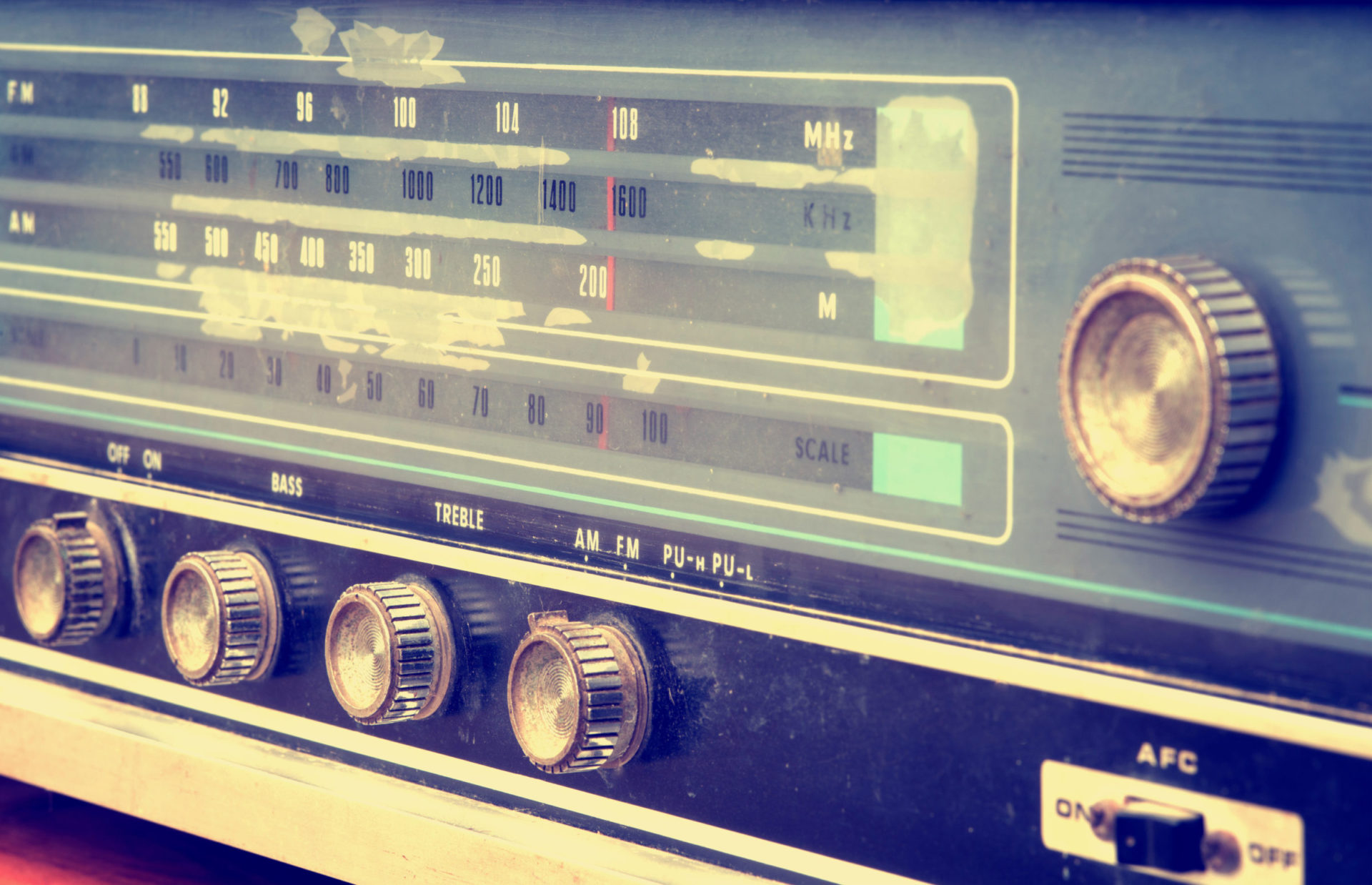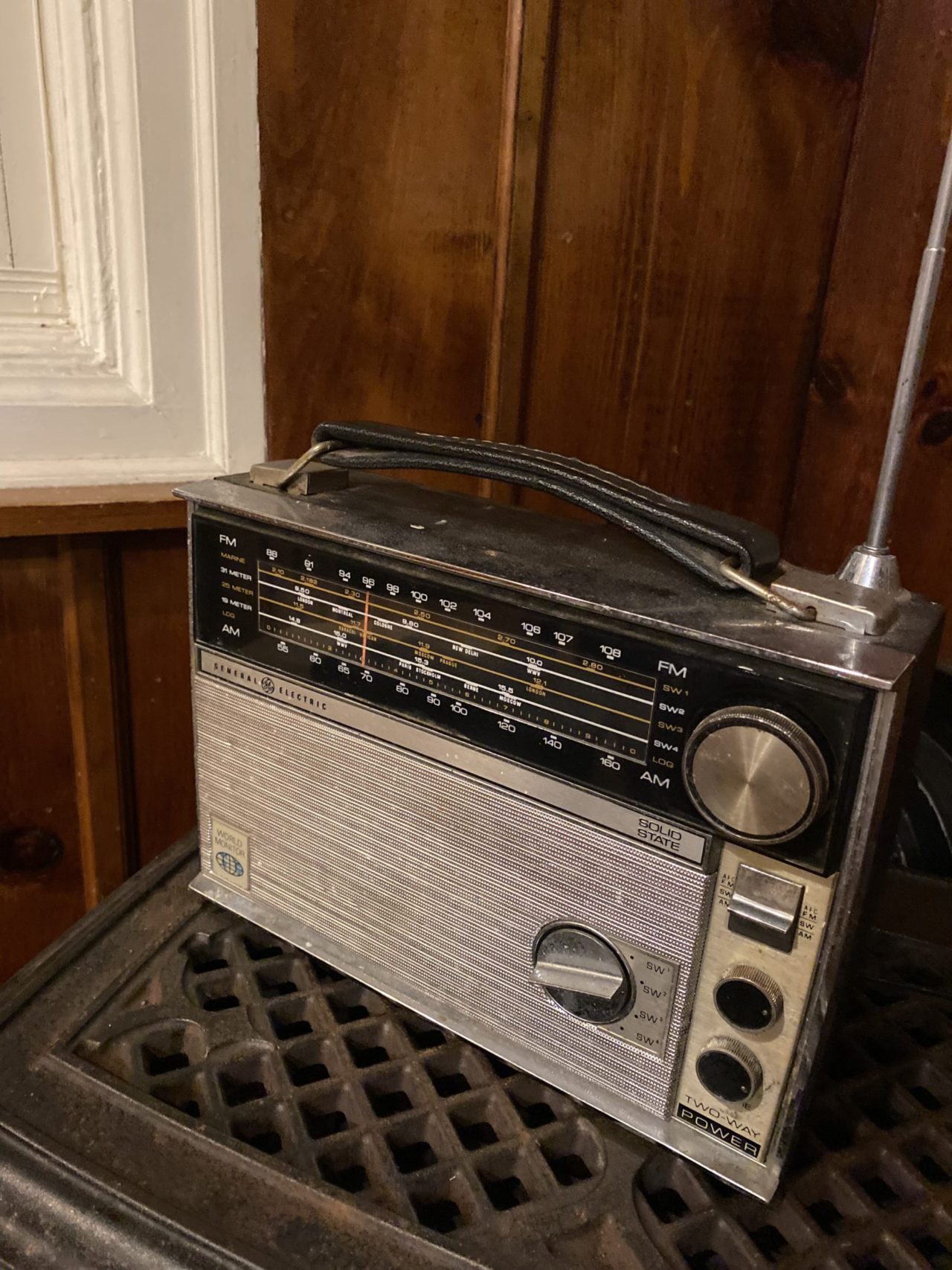
On the windowsill above the gas fire sits a surprisingly heavy square box. Its back is dirty, thick plastic; its battered and much-dented front is metallic, with rows of tiny ridges and microscopic holes creating a nubby texture if you run your hand across it. A leather strap is buckled into the top for ease of carry, in front of a retractable metal antenna. When the antenna is fully outstretched above the squat rectangle, it looks comical. In the top third of the box’s face, a vertical orange needle moves across the rows of numbers denoting frequency scales. You move the needle with a metal knob. There are four knobs in total, and a switch, and a few helpful legends: am/fm, volume, and, in neat, raised letters, general electric.
This is the family radio. It is at least fifty years old. My mother remembers her family listening to it after dinner; I remember sitting on the porch, hearing the Phillies playing in the background, summer after summer. The other night we turned it on again to catch the first game of the National League Championship Series. A few of the technologically savvy younger generation were home, and at first we tried to get the game on the big-screen Internet-enabled TV. Something was wrong with the pirating site, which is a tough situation for appropriately-directed complaint filing. You could get the game on the MLB app, but the app wants to know your cable provider, which precise lack was the reason we were on the app. Hulu was streaming it, apparently. We tried to sign up for a free trial that we could cancel before they’d get around to billing us. (This is not taking advantage of the free option, because we would have forgotten to cancel; if anything, Hulu is taking advantage of our rosy-eyed good intentions.) Of course it turned out that everyone had already at some point or other created a now-lapsed account; we would have to pay. No problem. We’re big like that. One of us tried to log in. None of us remembered our passwords. The message on the screen directed us to visit some variant of hulu.com/forgotpassword/idiot. We weren’t messing around with that. By now we were fifteen minutes past the start of the game.
Radio it would have to be. But at least we had our Internet-enabled big-screen TV speakers. We would listen to Internet radio and pipe the game through the whole downstairs. What was the name of the Philly station? How did the search function work? How long could painstakingly scrolling to and clicking on each requisite alphanumeric character with the touch-sensitive Apple remote possibly take? The answer to none of these questions mattered because, as it turned out, three increasingly incredulous searches later, Internet radio had never heard of our local broadcast station.
We pulled the long spindly antenna all the way up. We flicked the switch to FM. We twisted the volume knob as far as it would go. The warm familiar crackle — then Kyle Schwarber was in our living room, hitting a home run.
Things used to work in this country.

When we think of heirlooms, we usually think of objects cast in friendly and graceful materials: wood, wool, crystal, silver. We do not think of utilitarian confections of alien plastic. But our GE radio, our unstoppable GE radio, is one of our family heirlooms. It’s true that there is something pleasing about its design. Its amiable proportions and cleanly delineated squares and circles are coupled with a kind of serious banality in color and texture. It has the mystique of telephone wires, of walkie talkies, of legal pads, of Dana Scully’s suits, of playing “grownups” as a child: carrying briefcases, writing endless loops that were supposed to be cursive, in a world where it was and would always be the 1980s. As an object of nostalgia, its look will probably never match the jaunty brightness of the 1950s. But its already substantial following will doubtless continue to grow.
The GE radio is not a family heirloom for its design features, however. It is an heirloom because it has accompanied us through three generations of baseball games and school closure announcements and Saturday morning public radio folk hours. And it has accompanied us not because it had any particular emotional significance to begin with, but because it just works, and has worked, and continues to work. You can take it anywhere, plug it in anywhere. It does one thing perfectly. Well, not perfectly — it’s probably a little more prone to static than it was fifty years ago. The other day, when I turned it on, it made a noise like a gunshot and started shooting sparks out the back. But here’s the important thing: when the sparks died down, it worked.
I cannot think of a single piece of personal technology that I expect to be able to give to my grandchildren in working order. Some cars fit this bill, because there is an expectation and infrastructure of ongoing repairs. But in terms of smaller items? Apple, to give the devil his due, is probably the closest. I ran my iPhone over with a car last year; a quick trip to the electronic repair store and it may last me ten years, if Apple does not sabotage me with operating systems updates or charger modifications. But there’s nothing like the GE radio, nothing that I can expect to use, day in and day out, for fifty years, without touching it.
Things used to work in this country. This is the stock complaint of the Baby Boomers, and if you are lucky enough to inherit a piece of their technology, you may find yourself agreeing. But when I say “things used to work,” the object of inherited nostalgia is not only manufacturing standards before planned obsolescence and offshoring. Things used to, literally, work. You turned a knob, and sound came on, because the knob controlled the mechanism that tuned the radio to the broadcast that the big metal radio towers dotting the landscape beamed at you. I am not a gearhead of any description and don’t care much about how the insides of electrical devices work, but I know exactly what I, personally, have to do to operate my end of the GE radio. There are no downloads, no platforms, no passwords, no little pull-down menus, no verifications or account recovery protocols. There is no streaming. Personal technology used to be a machine. Now it’s a bureaucracy.
I like simple machines. I do not take “simple enough for a woman to use” to be a put-down. I take it as a vote of confidence that I will never be enough of a nerd (sorry, sorry: high-IQ techno-optimist) to think that syncing the smart refrigerator to the smart TV to the Alexa is a good use of any human being’s limited time on this earth. I like the way simple, sturdy machines unite generations rather than dividing them — because they are capable of being passed down, because their interfaces are built off broad intuitions about a limited range of actions (turn knob, push button), and because they can be mastered via direct experimentation that will not immediately take you down a hopeless rabbit hole of arcana and administration.
I like simple machines. But most of all I like the General Electric radio that connects us to the beneficence of public broadcasting, beaming out of the silent towers that stand like guardians of civilization. Trends come and go; cutting edges dull; shows get canceled; startups collapse. But our General Electric radio remains.
Exhausted by science and tech debates that go nowhere?